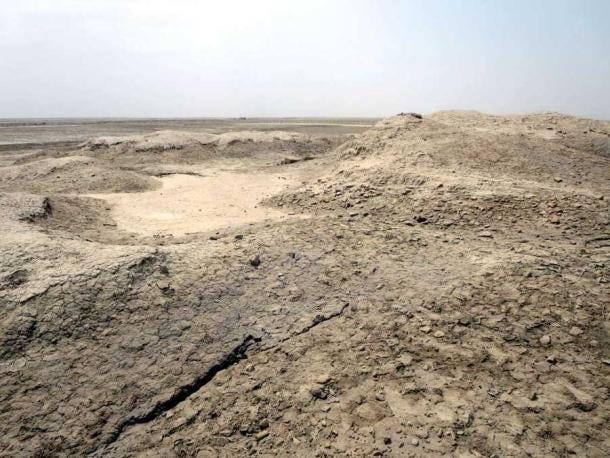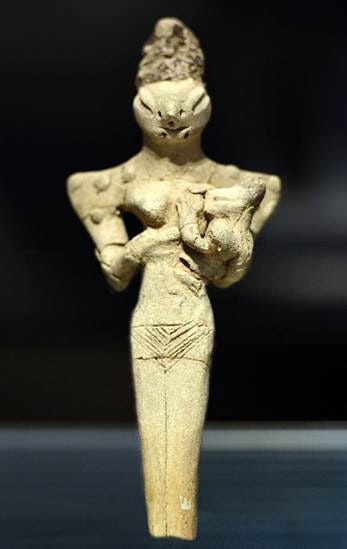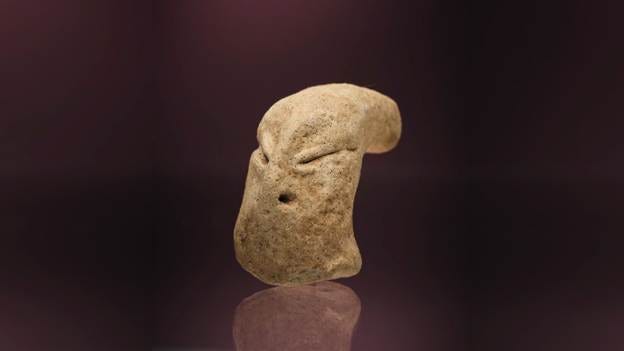The Enigmatic Ubaid Lizardmen: 7,000-Year-Old Mystery From Ancient Mesopotamia

What is the secret behind the reptilian features of these prehistoric clay figurines? Deep in the cradle of civilization, ancient artisans crafted mysterious sculptures that continue to baffle archaeologists - humanoid figures with distinctly lizard-like heads, almond eyes, and elongated skulls. Are they gods, shamans, or something else entirely? A groundbreaking 2024 discovery reignited this age-old mystery.
Lizards at the Beginning of Civilization?
It is a commonly accepted view in mainstream archaeology that civilization started in ancient Mesopotamia with the great civilization of Sumer in what is now modern-day Iraq. However, at the beginning of the 20th century, archaeologists excavating at Tell Al’Ubaid in Iraq made an unusual discovery when they unearthed several 7,000-year-old artifacts which appear to represent humanoid figures with reptilian features.

Understanding Ubaidian Culture
The Ubaid culture is a prehistoric culture in Mesopotamia that dates between 4000 and 5500 BC. As with the Sumerians, the origins of the Ubaid people is unknown. They lived in large village settlements in mud-brick houses and they had developed architecture, agriculture and farmed the land using irrigation.
The domestic architecture of the Ubaids included large T-shaped houses, open courtyards, paved streets, as well as food processing equipment. According to the Metropolitan Museum of Art, some of these villages began to develop into towns, temples began to appear, as well as monumental buildings such as in Eridu, Ur and Uruk, the major sites of the Sumerian Civilization. Sumerian texts explain that Ur was believed to be the first city.
Tell al-Ubaid is a small tell discovered near Ur in southern Iraq. (David Stanley / CC BY 3.0)
Discovering Ubaid Lizardmen Figurines at Tell Al’Ubaid
The main site where the unusual artifacts were discovered is called Tell Al’Ubaid – although figurines were also found in Ur and Eridu. The Al’Ubaid site is a small mound of about half a kilometer (0.3 mi) in diameter and two meters (6.56 ft) above ground. First excavated by Harry Reginald Hal in 1919, male and female figurines were found in different postures. Most of the figurines appear to be wearing a helmet and have some kind of padding on the shoulders.
Other figurines were found to hold a staff or scepter, possibly as a symbol of justice and ruling. Each figurine has a different pose but the strangest of all is that some female figurines hold babies suckling milk, with the child also represented as a lizard-type creature.
Lizard-headed nude woman nursing a child, from Ur, Iraq, c. 4000 BC, now at Iraq Museum. (Osama Shukir Muhammed Amin FRCP / CC BY-SA 4.0)
Ubaid Lizardmen: The Prehistoric Lizard Figurines
The figurines are presented with long heads, almond shaped eyes, long tapered faces and a lizard-type nose. What exactly they represent is completely unknown. According to archaeologists, their postures, such as a female figure breast-feeding, do not suggest that they were ritualistic objects. So what did these Ubaid lizardmen represent?
Whatever they were, they appear to have been important to the ancient Ubaidian people. We know that the serpent was a major symbol used in many societies to represent a number of gods, for example, the Sumerian god Enki, and the snake was used later on as the symbol for the Brotherhood of the Snake, supposedly an ancient secret society. Is there a link between the symbol of the snake and the representations of lizards?
First Ubaid Figurine Found Outside Mesopotamia
In a development that sent shockwaves through the archaeological community, researchers announced in December 2024 the discovery of a 7,000-year-old Ubaid-style figurine at Bahra 1, an archaeological site in northern Kuwait. This marks the first time such a figurine has ever been found in the Arabian Gulf region, expanding our understanding of the Ubaid culture’s geographic reach and influence.
The clay head unearthed at Bahra 1 in northern Kuwait dates back nearly 7,000 years. (Adam Oleksiak/CAŚ UW)
The small, finely crafted clay head features the characteristic elongated skull, slanted almond-shaped eyes, flat nose, and tapered face that define Ubaid “lizard-headed” or “ophidian” (snake-like) figurines. The discovery was made by a joint Kuwaiti-Polish archaeological team led by Agnieszka Szymczak from the University of Warsaw’s Polish Centre of Mediterranean Archaeology.
“Discovery of the figurine was a total surprise for the whole team, as it was the first such find not just among the over 1,500 small finds excavated from the Bahra 1 site but also from the Arabian Gulf region,” Szymczak told Live Science in December 2024.
Evidence of Ancient Cultural Exchange
What makes this discovery particularly significant is that the figurine was made from Mesopotamian clay, not the local “Coarse Red Ware” ceramics typical of the Arabian Gulf. This provides concrete evidence that the Ubaid people were actively importing their artistic traditions and cultural practices into the region during the sixth millennium BC.
According to Szymczak, during this period Bahra 1 became a “prehistoric crossroads of cultural exchange” where Ubaid culture from Mesopotamia intertwined with Neolithic societies in the Arabian Gulf, creating an ancient melting pot of ideas, art, and beliefs.
Aurelie Daems, a Near Eastern archaeologist at Ghent University in Belgium who has published extensively on Ubaid ophidian figurines, praised the Kuwait finding as having the “potential to clarify research questions related to ritual and social practices” of the Ubaid, as well as the relationships between the prehistoric Gulf region and Mesopotamia, according to Live Science.
New Scientific Theories About the Figurines’ Meaning
One of the most compelling recent theories suggests that the unusual “reptilian” features of these figurines may actually represent artificial cranial deformation - a practice where infants’ heads were deliberately shaped by binding them with cloth or boards while the skull was still malleable.
According to research published by the University of Chicago’s Institute for the Study of Ancient Cultures, skeletal remains from Ubaid sites in Mesopotamia show evidence of head-shaping practices. The Ubaid people may have adopted this custom from neighboring regions in what is now Iran during the eighth and seventh millennia B.C., with the practice reaching its peak during the fifth millennium B.C.
This cranial modification could have served as a symbol of identity - marking class distinctions, cultural belonging, or membership in special groups within Ubaid society. The figurines may therefore depict real people with deliberately modified skulls rather than supernatural beings or deities.
Multiple Interpretations Gain Scholarly Support
Recent archaeological analysis has identified several plausible interpretations for these mysterious figurines:
1. Fertility and Life Symbols The numerous figurines depicting nursing mothers with prominent breasts strongly suggest connections to fertility rituals. In an agricultural society dependent on successful harvests and healthy offspring, these figures may have been used in ceremonies to ensure abundance and the continuation of lineages.
2. Deities or Supernatural Beings The serpent motif’s prominence in later Mesopotamian religions supports the theory that these represent gods or demigods. The figurines wearing elaborate headdresses and holding scepters particularly suggest divine or priestly status. They may represent a serpent deity associated with the life-giving but potentially destructive waters of the Tigris and Euphrates rivers.
3. Shamanic Transformation Another theory proposes the figurines depict shamans - spiritual intermediaries believed to transform into animals to communicate with the spirit world. The reptilian features could represent this metamorphosis, showing humans in the process of becoming spiritual guides, healers, or diviners.
4. Guardians of the Afterlife Some figurines have been discovered in burial sites, suggesting they may have served as protectors or guides for the deceased on their journey to the next world, according to research compiled by Indrosphere in November 2024.
As noted in recent analyses, these interpretations are not mutually exclusive - the figurines may represent a complex interplay of all these elements, reflecting the Ubaid worldview and their understanding of the cosmos, nature, and the mysteries of life and death.
The Ubaid Legacy: Foundation of Mesopotamian Civilization
The Ubaid people’s innovations laid crucial groundwork for the Sumerian civilization that followed. Their advances in irrigation, temple architecture, and social organization became fundamental to Mesopotamian culture. The mysterious lizard figurines, whether they represent deities, transformed shamans, or elite individuals with modified skulls, offer a tantalizing glimpse into the spiritual and social world of humanity’s earliest civilizations.
The 2024 Kuwait discovery demonstrates that Ubaid influence extended far beyond the Mesopotamian heartland, reaching into the Arabian Peninsula and creating networks of cultural exchange that would shape the ancient Near East for millennia.
Yet despite over a century of study since their initial discovery in 1919, these enigmatic clay figures continue to guard their secrets. As excavations continue at Bahra 1 and other sites, archaeologists hope that new discoveries will finally unlock the mystery of the Ubaid lizardmen.
By Dr Ioannis Syrigos
References
Live Science: “7,000-year-old alien-like figurine from Kuwait a ‘total surprise’ to archaeologists“ (December 17, 2024)
Indrosphere: “Unraveling the Mystery of the Ubaid Lizard Figurines“ (November 5, 2024)
University of Chicago Institute for the Study of Ancient Cultures: “Beyond the Ubaid: Transformation and Integration in the Late Prehistoric Societies“ (2014)
Archaeological News: “Kuwaiti-Polish Team Discovers Figurine, Local Pottery, and Environmental Clues“ (December 2, 2024)







Love this!
Reptilians were simply extraterrestrial beings.